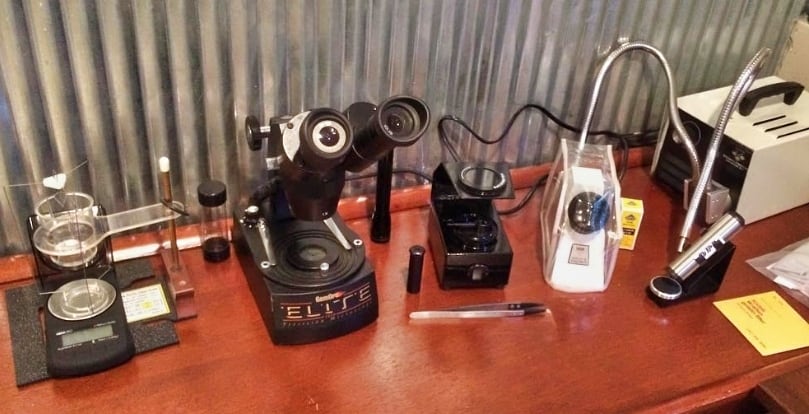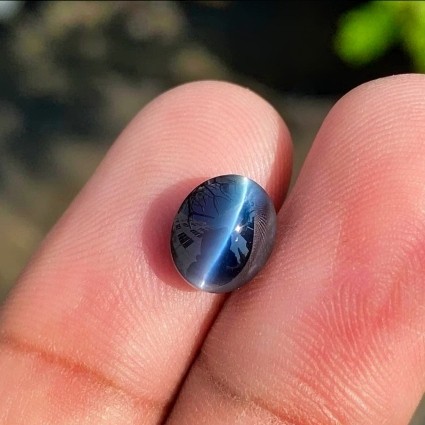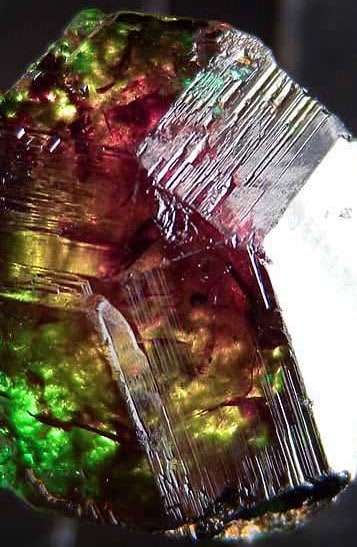Alexandrite is one of the most sought-after precious gemstones because it has a unique attribute that other precious gemstones don’t have. When it is placed in the sunlight, alexandrite shows a strong color change from bluish-green and red to purplish-red in incandescent light. A faceted alexandrite tends to have very few if any inclusions but you can come across cabochons that display a “Cat’s-Eye” phenomenon. The eye in the cat’s eye is caused by needle-like inclusions running in a parallel fashion.
Most faceted alexandrites are relatively small and weigh less than a carat. Larger-sized stones with a high clarity rating can bring extremely high price per carat.

How to Identify Alexandrite Through Testing
There are various ways to identify rocks, minerals, crystals, and gemstones, but we will be using a method I learned while attending the Gemological Institute of America. If you’ve learned a unique way to identify gemstones, then feel free to share it with us.
Let’s look deeper into how to identify Alexandrite like a pro.
Visual Inspection
The visual inspection starts with what form of alexandrite you have. The questions below are fairly easy to answer, but each type will have its own process for identifying them.

Is it a cabochon? If you’re dealing with a cabochon, then it should have a high polish with very little pitting on the surface. You’ll notice it’s metallic in color, bluish-green in natural light, but changes to a purplish-red shade in the lamplight. As stated above, you’ll see a cat’s eye effect like the one above.

Is it faceted? If you have a faceted piece of alexandrite, it should be transparent and you’ll want to use a 10x powered loop to view the interior. There’s a synthetic alexandrite which means you’ll need to be able to identify it. If the stone has no natural inclusions then more than likely it’s synthetic.

Is it a specimen? Alexandrite is found in different forms, and you’ll get better at identifying these forms by looking at and inspecting this mineral over time. Here’s a list of characteristics Alexandrite displays when it’s a specimen.
- Greenish-gray, bright green, and turquoise green colors. Some will have slight hues of black.
- You’ll be able to do the streak test. Keep reading below if you have a rough piece with no commercial value.
- An iridescence effect on the outside surface.
- It can be found in crystal form, but it’s rarer, and you’re not likely to come across it very often.
Is it tumbled? Due to its rarity, alexandrite is not tumbled and you won’t be seeing it in a tumbled form.
Physical Properties of Alexandrite
Let’s take a look at the physical properties of Alexandrite. Knowing what to look for will help you more easily identify what you’re looking at.
Color: Yellow, Green, Brown, Multicolored
Clarity / Transparency: Transparent to Opaque
Luster: Vitreous
Cleavage: Good
Fracture: Weak, Conchoidal
The Streak Test
This is a destructive test, so you need to ensure that you’re allowed to damage the specimen or stone if you choose to use this method. Once you’ve developed robust knowledge in identifying rocks and minerals, you won’t be using destructive tests.
A mineral streak test is when you scrape the stone against a harder surface to see what color remains. When dealing with Alexandrite, you’ll notice a white streak.
Raw Alexandrite can be streaked across a piece of colored paper to expose its color; Alexandrites are always white.
Tumbled specimens are tested by scraping a specimen across a piece of ungalvanized porcelain, typically known as a streak plate.
Magnet Test
Alexandrite shows a weak magnetic attraction when it’s floated due to iron impurities.
For instance, it’s entirely normal for Alexandrite to contain a considerable amount of magnetite. Since iron ore minerals are formed similarly, the two types may have combined during their chemical formation process. When this occurs, the chemical composition of Alexandrite changes, making the Alexandrite weakly attracted to magnets.
Hardness Test
I don’t recommend actively testing the hardness of a stone because it’s destructive in nature and doesn’t really provide a definite answer to what type of stone it is. With that being said, Alexandrite has a hardness of 8.5 on the Mohs hardness scale.
Refractive Index Test
Determining the refractive index, or RI as it’s referred to by gemologists, for Alexandrite is fairly straightforward, but you’ll need a specific piece of test equipment and the RI fluid to go with it. Before you place the stone on the refractometer, you want to make sure you have a flat, somewhat polished surface to take a reading.
Alexandrite’s Refractive Index: 1.74 – 1.76
Each gemstone has its own RI, so discovering a sample’s RI can help you figure out what sort of stone it actually is.
Step 1 – Place a small bead of RI fluid on the metal surface of the refractometer near the back of the crystal hemicylinder (the window on which the stone will sit).
Step 2 – Place the stone facet face down on the fluid dot and slide it toward the middle of the hemicylinder crystal using your fingers.
Step 3 – Look through the viewer lens without magnification. Continue looking until you see the outline of a bubble, then look at the bottom of this bubble. Take the reading from there, rounding the decimal to the nearest hundredth.
From time to time, you’ll run into the issue of not having a flat surface to work with. In this instance, you’ll need to leave the top of the refractometer open and hold the rounded stone with your hand. Hopefully, you’ll be able to pull a reading off of the gauge.
Birefringence Test
Consider testing the birefringence, as well. Birefringence is related to RI. While doing the birefringence test, you will turn the gemstone on the refractometer six times throughout the observation period and note the changes.
Perform a standard RI test. Instead of keeping the stone still, gradually turn it 180 degrees, making each separate turn about 30 degrees. At each 30-degree mark, take a new RI reading.
Subtract the lowest reading from the highest to find the stone’s birefringence. Round it to the nearest thousandth.
Birefringence: 0.007 – 0.011
Single or Double Refraction
Alexandrite is doubly refractive.
For this test to be accurate and beneficial, the stone needs to be transparent in nature. If the light won’t pass through the stone, then there is no way to test for single or double refraction.
Check for single or double refraction. Use this test on translucent and transparent stones. You can determine whether the stone is only singly refractive (SR) or doubly refractive (DR) to help identify it. Some stones can also be classified as aggregate (AGG).
Turn on the light of a polariscope and place the stone face down on the lower glass lens (polarizer). Look through the top lens (analyzer), turning the top lens until the area around the stone looks darkest. This is your starting point.
Turn the analyzer 360 degrees and watch how the light around the stone changes.
If the stone appears dark and stays dark, it is likely an SR. If the stone starts light and remains light, it is likely AGG. If the lightness or darkness of the stone changes, it is likely DR.
Checking The Diaphaneity
Diaphaneity refers to the mineral’s ability to transmit light. For instance, some minerals are transparent or translucent. When they’re thick, a small amount of distortion might occur, but light will pass through them relatively freely.
Alexandrite is transparent to opaque. However, its translucency depends on the form it has taken. In an earthy form, the gem will be opaque. Otherwise, it is translucent.
Finding The Specific Gravity
Every stone has its unique specific gravity, which helps us identify them. Specific gravity is one of the best properties to measure when identifying mineral specimens. Most minerals have a narrow range of specific gravity, so getting an accurate measurement can go a long way toward identification.
Specific gravity is a unitless number describing how heavy a mineral is compared to equal volumes of water. For example, if a mineral is three times as dense as water, it’ll have a specific gravity of three. This is useful because while two minerals might be the same size, they’ll each have a different specific gravity.
The larger the sample, the more precise the readings tend to be. Remember that this technique can only be used for single mineral or crystal masses. It will not work for minerals embedded in host rocks.
Alexandrite’s Specific Gravity: 3.70 – 3.78
As helpful as specific gravity is for identifying minerals, amateurs are usually constrained by the lack of necessary tools for the job. However, one way to work around this is to hold the specimen and note how heavy or heft it feels compared to what you might expect a specimen of that size to weigh.
If you want to determine the specific gravity of your stone like a pro, then you’ll need to invest in a higher-end scale. This is the one gemologists use OHAUS Density Determination Kit
Identifying Rocks and Minerals Like a Pro
Hopefully, you feel confident in your practice to identify a piece of Alexandrite after reading and applying this guide. You’ll be using the visual part of this guide the most, and you’ll get better as you interact with more gemstones. Before you know it, you’ll be identifying stones like a gemologist.
If you run into any issues or get confused, then feel free to reach out, and I’ll do my best to assist you in the identification process.
- Identify Enstatite - March 12, 2024
- Identify Cerussite - March 3, 2024
- Identify Bytownite - February 18, 2024

4 Responses
I have a stone that is close to the characteristics of alexandrite stone, but where I am there is no laboratory to identify the stone. Can my stone be identified via video or photo ?
Frits – I emailed you directly
I have a family favorite gem from my mother’s side of the family story goes that my great great great grandfather was a commander in Napoleons army and acquired said rough gemstone in his Russian campaign the gemstone is a blueish green heavier on the green and in low light and in the dark it changes to a raspberry red it’s 62 carats need help identifying it and appraisal appreciate any help
Robert – You probably have synthetic Alexandrite. If the stone is genuine then it would be worth a large sum of money. The best way to proceed would be to find a graduate gemologist local to you and have them identify it.